Stretching across the east of England, Lincolnshire is a county of quiet majesty and unexpected variety. It is England’s second largest county by area, yet often one of its most overlooked, lying between the Humber in the north and the Wash in the south. Its landscapes are shaped by contrasts: the fertile flatlands of the Fens, the rolling beauty of the Lincolnshire Wolds, the broad skies of the marshes and coasts, and historic towns that have witnessed centuries of change.
At its heart lies the city of Lincoln, once a major Roman settlement and later a medieval centre of power. Its cathedral was for centuries the tallest building in the world, while the castle still houses one of the four surviving copies of Magna Carta. Narrow cobbled streets such as Steep Hill connect this ancient core with vibrant modern quarters, blending heritage with present-day life.
Beyond Lincoln, the county reveals a rich patchwork of experiences. Market towns like Stamford, Louth, and Alford preserve traditional rhythms of English life, while Boston tells a transatlantic story through its links to the Pilgrims who would sail to the New World. The stately homes of Burghley, Belton, and Gainsborough showcase centuries of aristocratic ambition, their architecture matched by landscaped parks and gardens.
Lincolnshire also has a proud association with aviation. During the Second World War, it was known as “Bomber County,” hosting countless airfields. Today, this legacy is preserved at RAF Coningsby, East Kirkby, and the Battle of Britain Memorial Flight, where the roar of a Lancaster bomber or a Spitfire still stirs the skies.
On the coast, the county offers both tradition and wildness. Resorts like Skegness and Mablethorpe recall the golden age of the English seaside, while nature reserves such as Gibraltar Point and Donna Nook provide sanctuaries for wildlife, from migrating birds to grey seals.
Lincolnshire is therefore a county of many faces: deeply historic, proudly agricultural, rich in cultural heritage, and shaped by its wide horizons. It rewards slow exploration, offering both quiet beauty and monumental stories that have shaped England and beyond.
Lincoln
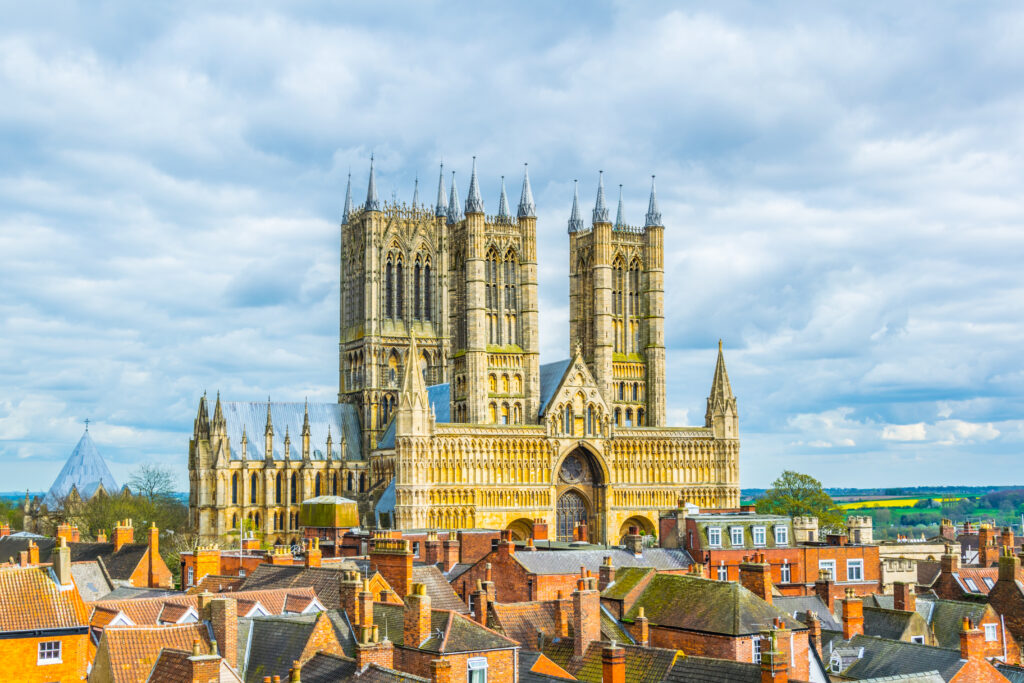
Few places in England capture the sweep of history as vividly as Lincoln, where medieval grandeur crowns a Roman foundation. Rising high above the flat Lincolnshire plains, the city is dominated by its twin monuments: Lincoln Cathedral and Lincoln Castle, standing almost side by side on the historic hilltop.
The cathedral, begun in 1072, is one of Europe’s great Gothic buildings. For nearly 250 years, its soaring central spire made it the tallest structure in the world. Though the spire has long since collapsed, the cathedral remains awe-inspiring, with its intricate stonework, cavernous nave, and stained-glass windows that flood the interior with shifting light. Its “Lincoln Imp”, a mischievous gargoyle perched high above, has become the city’s emblem.
Across the way stands Lincoln Castle, founded by William the Conqueror. Within its mighty walls lies a Victorian prison and, most importantly, a rare 1215 Magna Carta, one of only four originals in existence. Walking the castle’s medieval walls offers panoramic views across the city and the wide countryside beyond.
Linking these monuments to the bustling lower city is Steep Hill, a cobbled street so sharply angled it is almost a pilgrimage in itself. Along its climb are bookshops, tearooms, and independent boutiques, leading into the Bailgate area, where Roman gates and medieval buildings coexist with lively cafés and markets.
Together, cathedral, castle, and cobbled streets make Lincoln a jewel among England’s historic cities. It is a place where the past is not only preserved but lived in daily, where each stone and lane tells a story stretching back nearly two millennia.
Boston & St Botolph’s Church
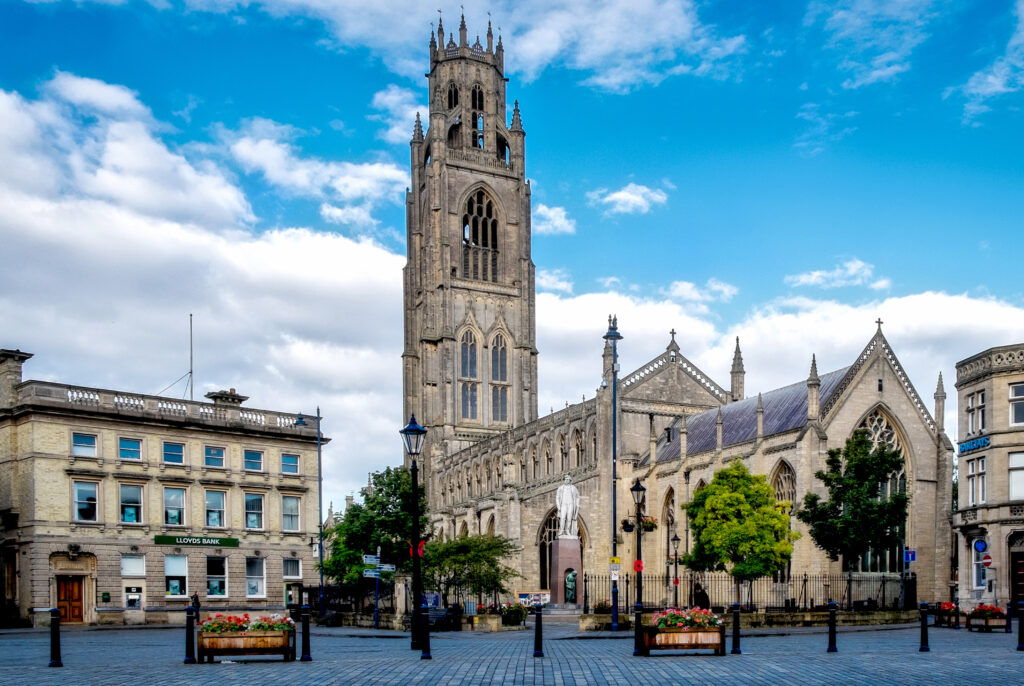
On the southern edge of Lincolnshire lies Boston, a historic port town whose fortunes once rivalled those of London. In the Middle Ages, Boston was a thriving centre of the wool trade, exporting English fleece to Europe and importing goods from across the continent. Its prosperity is still reflected in its proud streets and, most of all, in its monumental church.
St Botolph’s Church, known affectionately as “The Stump”, dominates the flat Fenland landscape. With its soaring 272-foot tower, it is one of the tallest parish churches in England and can be seen for miles across the surrounding countryside. Built between the 14th and 16th centuries, the church embodies both the wealth and the devotion of the medieval town. Its interior is vast, light-filled, and intricately carved, rivaling many cathedrals in scale and splendour. Visitors who climb the tower are rewarded with panoramic views of the town, the Fenlands, and, on a clear day, even the coast.
Boston also has a remarkable transatlantic connection. In 1607, a group of Separatists—later known as the Pilgrim Fathers—attempted to flee England from here in search of religious freedom. Though captured, some eventually made their way to America, where they helped found Plymouth Colony. This link is celebrated today with memorials and museums, reminding visitors of Boston’s role in shaping the New World.
Modern Boston remains a working market town, surrounded by fertile agricultural land that has earned the area the nickname “the breadbasket of England.” Its blend of medieval grandeur, international history, and rural character makes it one of Lincolnshire’s most distinctive destinations.
Stamford
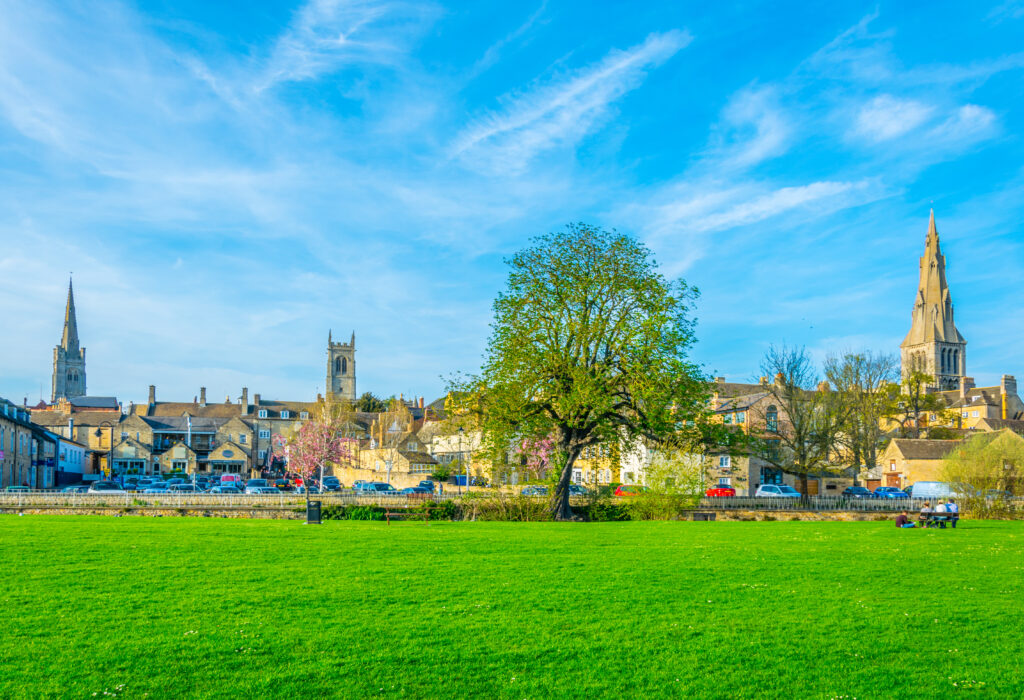
Few towns in England are as perfectly preserved as Stamford, widely regarded as the country’s finest Georgian stone town. Its honey-coloured limestone buildings, cobbled alleys, and graceful churches have earned it both conservation status and a reputation as a living film set, often used in period dramas.
Stamford grew wealthy from the wool trade, but its true golden age came in the 18th century, when the coaching routes between London and the north transformed it into a bustling hub. Many of its elegant inns and townhouses survive, giving the town an air of refined continuity. St Martin’s, All Saints, and St Mary’s churches stand proudly over the streets, while the meandering River Welland adds a touch of natural beauty.
The town also boasts a vibrant cultural scene. Its historic Stamford Arts Centre offers theatre, cinema, and galleries, while the cobbled Broad Street hosts lively markets. The surrounding countryside, dotted with stately homes and rolling farmland, adds to its charm.
Stamford’s blend of history, elegance, and community spirit make it a town of enduring appeal, widely seen as one of England’s architectural jewels.
Burghley House

Just outside Stamford rises Burghley House, one of the greatest Elizabethan prodigy houses in England. Built by Sir William Cecil, chief minister to Queen Elizabeth I, it reflects the ambition and magnificence of the Tudor court.
Burghley’s façade is a vision of turrets, pinnacles, and grand proportions. Inside, the state rooms dazzle with elaborate ceilings, tapestries, and paintings. The Hell Staircase and Heaven Room, painted by Antonio Verrio, are masterpieces of Baroque decoration. Burghley is also home to an exceptional art collection spanning centuries.
The estate’s parkland, landscaped by Capability Brown, offers sweeping vistas and serene lakes. Its contemporary sculpture garden adds a modern contrast, with ever-changing installations among lawns and trees.
Today, Burghley is not only a historic treasure but also a cultural landmark, hosting the internationally renowned Burghley Horse Trials, a highlight of the equestrian calendar. It embodies grandeur, creativity, and a living tradition of excellence.
Grantham & Belton House

Grantham, a market town on the River Witham, is best known as the birthplace of Sir Isaac Newton, who grew up at nearby Woolsthorpe Manor. The town itself is steeped in history, with St Wulfram’s Church boasting one of the tallest spires of any English parish church.
Just outside Grantham lies Belton House, often described as the perfect English country house. Built in the 1680s for Sir John Brownlow, it epitomises the Restoration style with its symmetrical elegance. The interior combines opulent rooms with intimate spaces, while the grounds feature formal gardens, a boating lake, and expansive parkland.
Belton is also famous for its deer park, where herds still roam freely, adding a sense of timeless grandeur. Today, managed by the National Trust, it is a place where heritage meets leisure, with children’s adventure playgrounds alongside baroque architecture.
Together, Grantham and Belton offer a picture of Lincolnshire’s contribution to science, architecture, and English life.
Gainsborough Old Hall
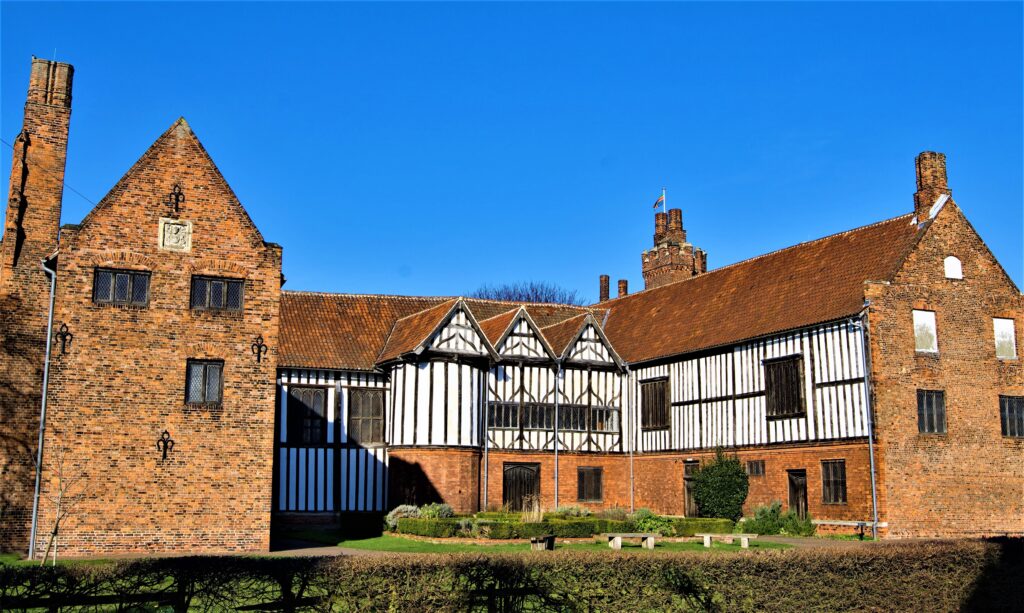
Gainsborough Old Hall is one of the best-preserved medieval manor houses in England. Built in 1460, its timber-framed exterior and great hall offer a glimpse into the life of the nobility during the late Middle Ages.
The hall’s history is rich. It hosted Richard III and Henry VIII, linking it directly to the great dramas of the Tudor period. Later, it became associated with the Separatists who would sail on the Mayflower, tying it to the Pilgrim Fathers’ story.
Inside, visitors can explore the vast Great Hall, medieval kitchens, and winding staircases leading to atmospheric rooms. The imposing brick tower offers panoramic views over the town and River Trent.
Gainsborough itself retains an industrial heritage, but the Old Hall is its jewel, standing as a testament to resilience and preservation. It is a building where centuries of politics, religion, and community life converge.
Sleaford & Cogglesford Watermill
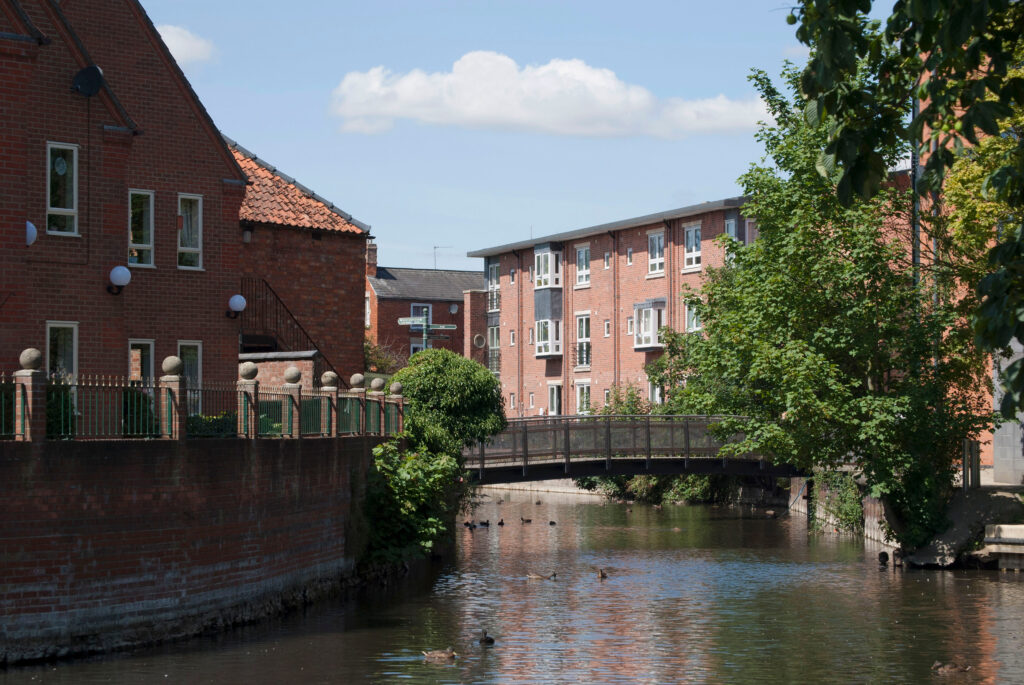
Sleaford is a market town that has retained its rural character while developing modern vibrancy. At its heart flows the River Slea, lined with historic mills and warehouses that speak to its role as a trading hub.
The town’s most unique treasure is Cogglesford Watermill, the only fully operational watermill in Lincolnshire. Records suggest a mill has stood on this site for over 1,000 years, and it continues to grind flour today using traditional methods. Visitors can watch the giant wheel turn, buy freshly milled flour, and experience a rare continuity of craftsmanship.
Sleaford is also home to the National Centre for Craft & Design, which brings contemporary art into dialogue with the town’s heritage. This combination of tradition and creativity defines Sleaford’s character: a small town with a big cultural footprint.
Tattershall Castle

Rising unexpectedly from the flat Fenland landscape, Tattershall Castle is one of England’s finest brick-built medieval castles. Constructed in the 15th century by Ralph Cromwell, Lord Treasurer of England, it stands as a striking example of wealth and ambition expressed in brick—a novel material at the time.
The castle’s soaring red tower dominates the site. Visitors can climb its winding staircases to reach the battlements, where wide views stretch across Lincolnshire’s countryside. Inside, great fireplaces and echoing chambers evoke its former splendour.
Saved from demolition in the early 20th century by Lord Curzon of Kedleston, Tattershall also represents one of the first major victories of the conservation movement. Today, it is managed by the National Trust and remains a place of drama, history, and inspiration.
RAF Coningsby & Battle of Britain Memorial Flight
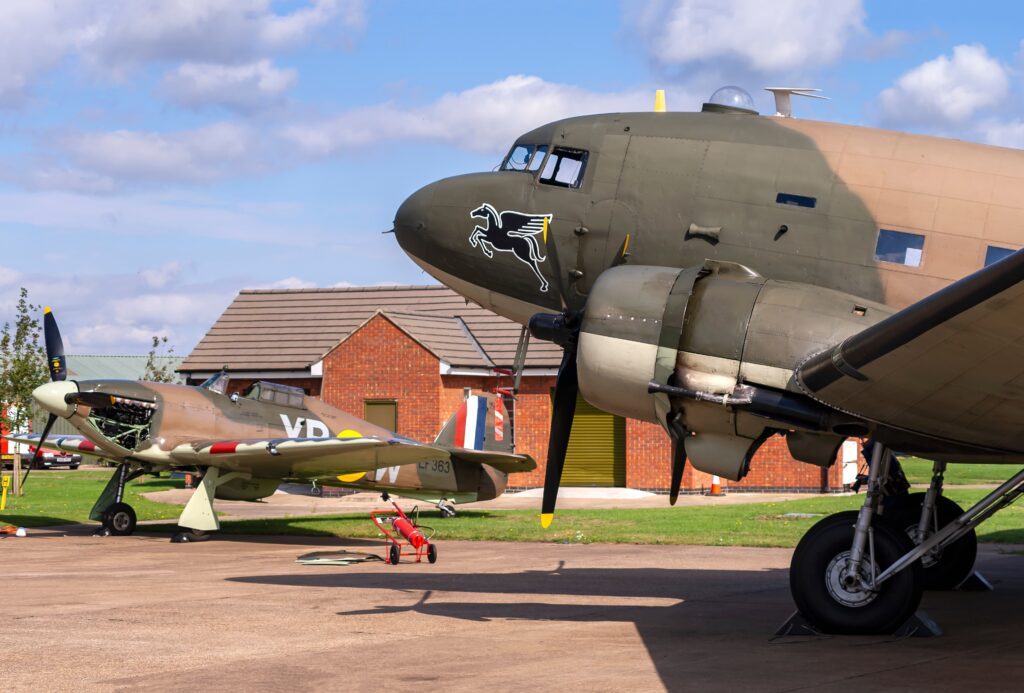
Lincolnshire is often called “Bomber County”, and nowhere reflects that legacy more than RAF Coningsby. Still an active base, it is also home to the Battle of Britain Memorial Flight (BBMF), a living tribute to the aircrews who defended Britain in its darkest hours.
The BBMF preserves and flies a historic fleet of aircraft, including the legendary Avro Lancaster, Spitfires, and Hurricanes. Seeing these icons in flight is deeply moving; their roar across the skies links past and present in a visceral way.
Visitors can take guided tours of the hangars, where aircraft are maintained to exacting standards. Veterans and volunteers often share personal stories, adding human depth to the mechanical heritage.
RAF Coningsby is not just a museum—it is a working tribute, ensuring that the legacy of the Battle of Britain remains alive for future generations.
Heckington Windmill
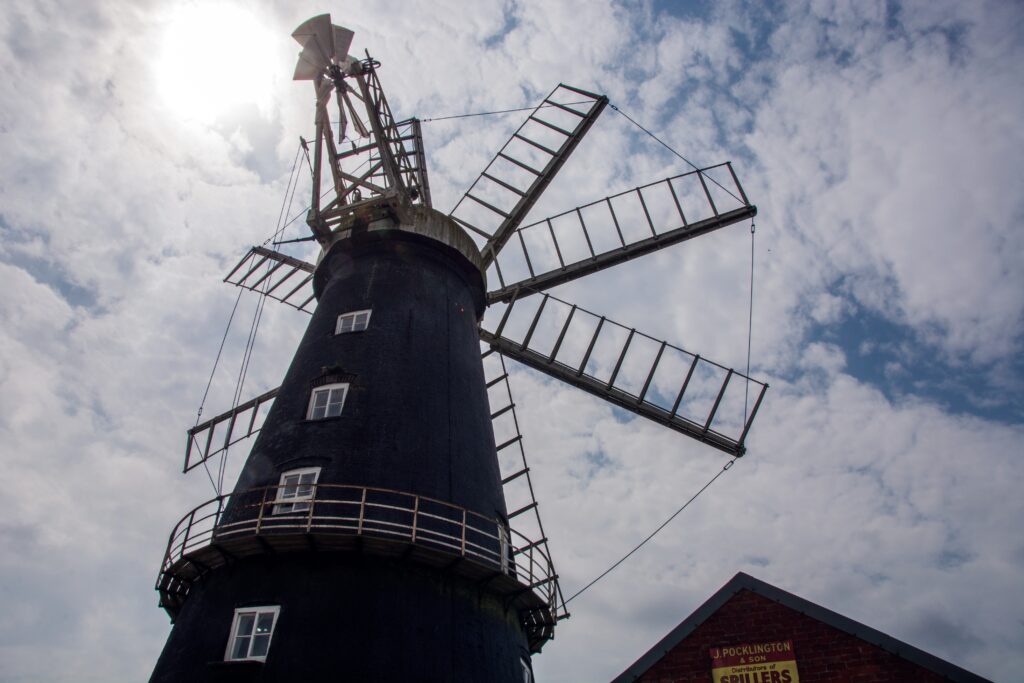
Standing tall on the flat fenland horizon, Heckington Windmill is a remarkable survivor of Lincolnshire’s agricultural past. Built in the 1830s, it is the only working eight-sailed windmill in the world, an engineering marvel that continues to capture the imagination of visitors.
Still operational, the mill grinds flour using wind power, and visitors can watch its giant sails turn majestically against the sky. The on-site visitor centre and café provide insights into the history of milling and the role windmills played in sustaining rural communities.
Every summer, the Heckington Show, the largest village show in England, celebrates local agriculture, crafts, and tradition, drawing crowds from across the region. The windmill stands at the heart of this identity, a proud symbol of resilience and ingenuity.
As a living monument to Lincolnshire’s rural heritage, Heckington Windmill connects engineering, agriculture, and community life in a way few landmarks can.
East Kirkby Aviation Centre

Nearby, the Lincolnshire Aviation Heritage Centre at East Kirkby offers another powerful glimpse into wartime history. Run by the Panton family in memory of a brother lost in the war, it houses one of the only two taxiable Lancaster bombers in the world: “Just Jane.”
Though she no longer flies, watching “Just Jane” thunder down the runway is unforgettable, recreating the sound and drama of a wartime take-off. The centre also holds an impressive collection of vehicles, uniforms, and personal artefacts, telling the story of Bomber Command from both British and international perspectives.
Unlike larger museums, East Kirkby has a deeply personal feel. It honours not only the aircraft but also the individuals whose lives were shaped by the war. This intimacy makes it one of the most affecting aviation sites in Britain.
Skegness & the Lincolnshire Coast
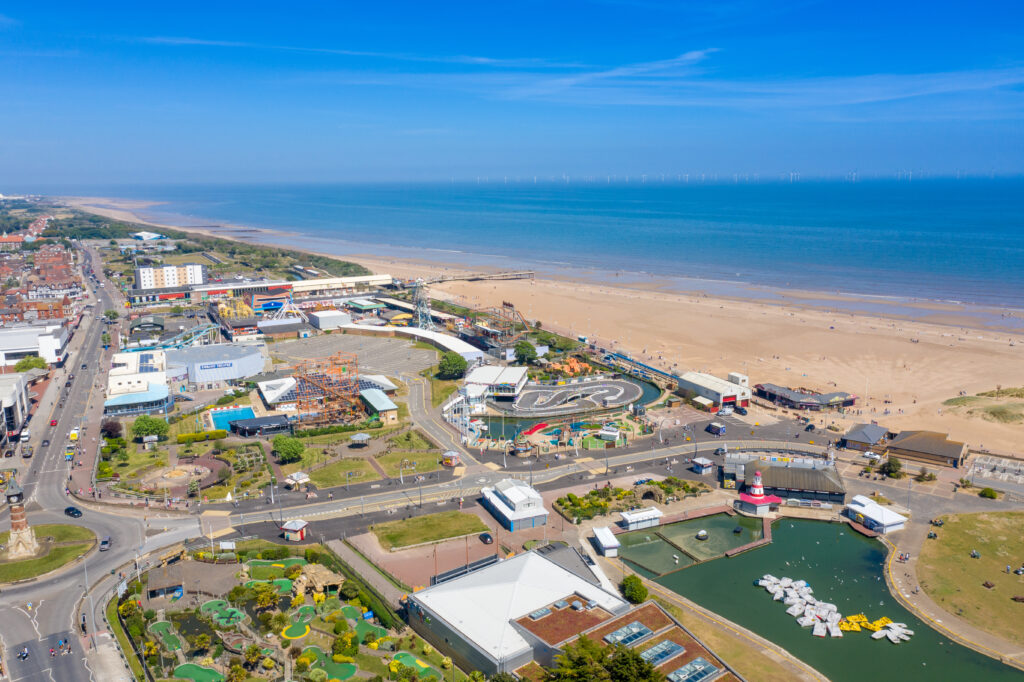
On the eastern edge of the county, Skegness embodies the traditional British seaside holiday. With its golden sands, lively promenade, and family attractions, it has been welcoming visitors since the late 19th century, when the railways first made coastal leisure accessible.
The resort’s famous Jolly Fisherman mascot and “Skegness is so bracing” slogan reflect its enduring charm. Amusement arcades, donkey rides, and fish-and-chip shops recall classic seaside traditions, while modern aquariums and leisure parks add new appeal.
Further along the coast, resorts such as Ingoldmells, Mablethorpe, and Sutton-on-Sea continue the theme, though Skegness remains the undisputed hub.
What makes this coastline special is its combination of fun, nostalgia, and openness. The vast skies and breezy air lend Skegness a freshness that has kept generations returning.
Gibraltar Point National Nature Reserve

Just south of Skegness lies Gibraltar Point, a stretch of unspoiled coast where dunes, saltmarsh, and lagoons form a haven for wildlife. Managed by the Lincolnshire Wildlife Trust, it is internationally recognised for its birdlife, attracting migratory species from across Europe and beyond.
Visitors can explore trails through shifting sands and tidal flats, watching waders, wildfowl, and, at certain times, rare migrants. The modern visitor centre offers information, bird hides, and a café with sweeping views over the marshes.
What sets Gibraltar Point apart is its atmosphere of solitude. Unlike busier resorts, it offers space for quiet reflection, where sea and sky merge in ever-changing patterns. It is a place of natural drama and serenity, showing a wilder side of Lincolnshire’s coast.
Mablethorpe & Sutton-on-Sea
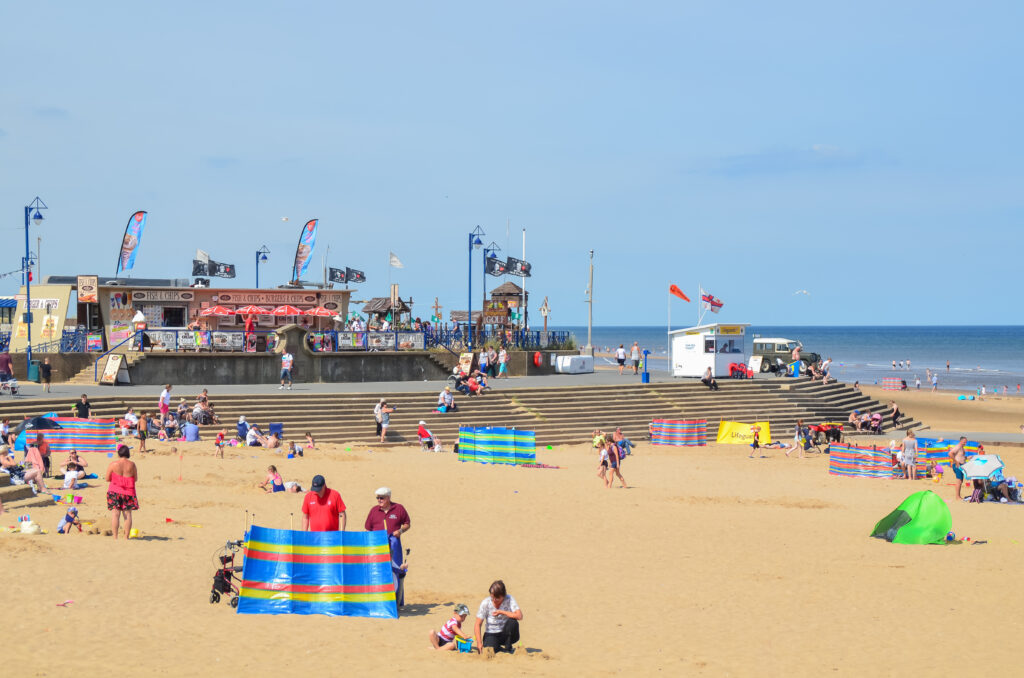
North of Skegness lies Mablethorpe, a much-loved seaside town with a family-friendly atmosphere. Its long sandy beach stretches for miles, backed by dunes and dotted with colourful beach huts. Unlike larger resorts, Mablethorpe retains a traditional, small-town charm where donkey rides, arcades, and ice creams still define the summer holiday experience.
A highlight is the Lincolnshire Coast Light Railway, one of the oldest narrow-gauge railways in the world, where visitors can ride vintage trains through the sand dunes. Nearby, Sutton-on-Sea offers a quieter alternative, with a genteel promenade, beach huts, and peaceful sands ideal for families and walkers seeking tranquillity.
Together, Mablethorpe and Sutton-on-Sea capture the essence of the English seaside: cheerful, nostalgic, and refreshingly unpretentious.
Spalding

In the fertile fens of South Holland lies Spalding, long celebrated as the heart of Britain’s bulb-growing industry. For much of the 20th century, its fields bloomed in dazzling stripes of tulips and daffodils, attracting tourists from across the country.
Though large-scale flower tourism has declined, Spalding’s legacy remains visible in its festivals, gardens, and heritage trails. The Ayscoughfee Hall Museum and Gardens tell the story of the town’s growth, while the surrounding waterways recall its history as a market hub.
Spalding is also known for its links to the River Welland and the fenland landscape, where flat horizons and vast skies create a unique sense of openness. Its blend of horticultural heritage and rural charm makes it a place of colour and history.
The Lincolnshire Wolds

In stark contrast to the flat fens, the Lincolnshire Wolds rise gently across the north-east of the county, designated an Area of Outstanding Natural Beauty. Rolling hills, hidden valleys, and winding lanes create a landscape of quiet loveliness, dotted with farms, woodlands, and picturesque villages.
The Wolds are ideal for walking and cycling, with trails such as the Viking Way offering panoramic views over the Humber and the Wash. Wildlife flourishes here, from skylarks singing above fields to hares darting across meadows.
This is a landscape of subtle beauty rather than drama, but its tranquillity is its strength. In the Wolds, time seems to move more slowly, offering visitors a glimpse of rural England at its most timeless.
Louth
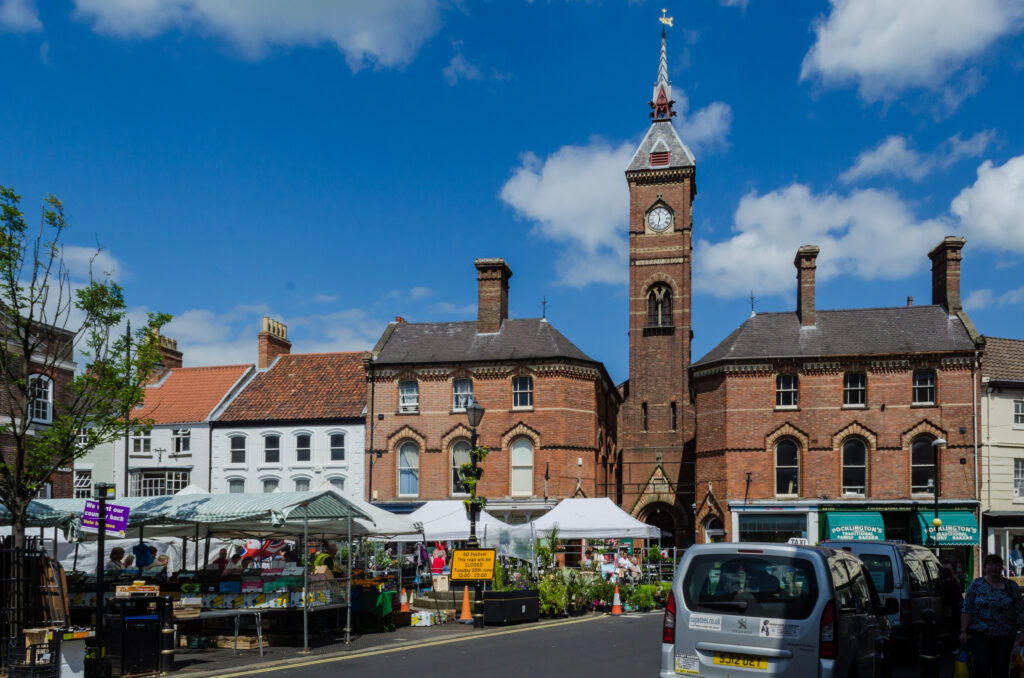
At the heart of the Wolds lies Louth, often called the “capital” of the area. A classic market town, Louth is known for its independent shops, traditional butchers and bakers, and lively weekly markets that continue centuries-old traditions.
The town’s skyline is dominated by St James’ Church, whose spire, at 295 feet, is the tallest of any parish church in England. The church is a masterpiece of late medieval design, and climbing the tower offers spectacular views over the Wolds and beyond.
Louth is also a centre for local food culture, hosting festivals that celebrate Lincolnshire produce. With its mix of heritage, community, and landscape, it represents the very best of small-town England.
Alford

Nestled at the edge of the Lincolnshire Wolds, Alford is a small market town with a rich tradition of crafts and heritage. Its crowning jewel is the Alford Manor House, a striking 17th-century building and one of the largest thatched manor houses in England. Today, it serves as a museum, offering an intimate look into rural life across centuries, from Georgian parlours to Victorian kitchens.
Alford is also celebrated for its strong craft community. The town hosts regular craft markets, fairs, and festivals, where artisans display everything from pottery to textiles. This creative spirit gives the town a unique vibrancy, setting it apart from other Lincolnshire destinations.
With its blend of historic architecture, living traditions, and Wolds setting, Alford provides a charming window into both the past and present of rural Lincolnshire.
Donna Nook

Every autumn, the remote saltmarshes of Donna Nook host one of Britain’s most remarkable wildlife spectacles. Thousands of grey seals come ashore to give birth, transforming the beach into a nursery of pups and protective mothers.
Designated viewing areas allow visitors to witness the colony without disturbing it. The sight—and sound—of hundreds of seals sprawled across the sand is unforgettable, offering an intimate connection with nature rarely seen so close to home.
Outside the seal season, Donna Nook is a tranquil coastal reserve, popular with birdwatchers. But in November and December, it becomes one of Lincolnshire’s most magical places, a reminder of the county’s role as a refuge not just for people, but for wildlife too.

